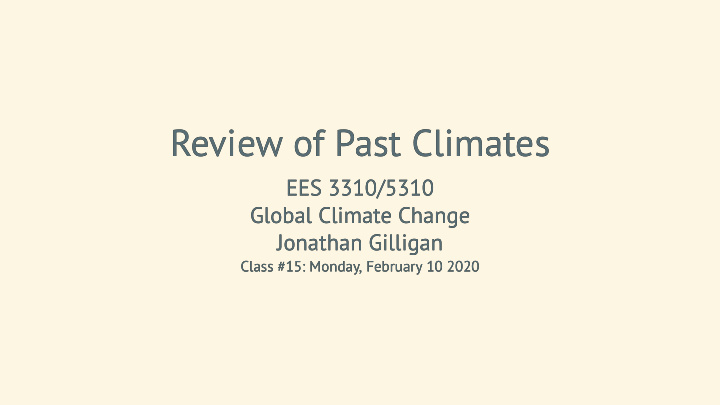



Review of Past Climates Review of Past Climates EES 3310/5310 EES 3310/5310 Global Climate Change Global Climate Change Jonathan Gilligan Jonathan Gilligan Class #15: Class #15: Monday, February 10 Monday, February 10 2020 2020
Summary of Oxygen Isotopes Summary of Oxygen Isotopes Two different uses: in glacial ice tells us about air temperature : 18 δ O Greater (less negative) means warmer temperature. 18 δ O in sea-floor sediments (skeletons of deep-sea organisms) tells us about sea level : 18 δ O Greater (more positive) means lower sea-level. 18 δ O During ice-age cycles: cold temperatures go with low sea-level is lower than usual in glaciers, higher in sea-floor sediments. 18 δ O warm temperatures go with high sea-level : is higher than usual in glaciers, lower in sea-floor sediments. 18 δ O
Abrupt Climate Change Abrupt Climate Change
Abrupt Climate Change Abrupt Climate Change
Abrupt Climate Change Abrupt Climate Change
Cold Pool in North Atlantic Cold Pool in North Atlantic Warming Trend: 1900–2013
Climate in the Climate in the Last Millennium Last Millennium
Walker River Walker River
Relict Tree Stumps Relict Tree Stumps
Relict Tree Stumps Relict Tree Stumps
Lake Tanaya, Yosemite Lake Tanaya, Yosemite
Chaco Canyon Chaco Canyon
Reconstructing Megadroughts Reconstructing Megadroughts
Dust Bowl vs. Megadroughts Dust Bowl vs. Megadroughts 1930s “Dust Bowl” 6 years 25% reduction in rainfall in plains states Hundreds of thousands of refugees Medieval Megadroughts: Multiple droughts 60 years or longer (up to 240) 40% reduction of rainfall in plains states
Questions about Carbon Cycle? Questions about Carbon Cycle?
Questions about MODTRAN? Questions about MODTRAN?
MODTRAN: MODTRAN: MODTRAN calculates emissions and absorption of longwave light in the atmosphere. Things that don’t change during a run: Heat from the sun Set by “locality” of the atmosphere Temperature of the ground and every layer of the atmosphere. Set by “locality” of the atmosphere and “temperature offset” Locale I out (W/m 2 ) T ground (K) U.S. Standard Atmosphere 267.98 288.2 Tropical 298.67 299.7 Midlatitude winter 235.34 272.2 For every wavenumber, MODTRAN calculates heat emission and absorption up and down at each layer.
MODTRAN: MODTRAN: Looking down from space: Emissivity ( ) = absorption ε You see emission at the temperature of Fraction absorbed by layer = ε the highest layer with large . Radiation emitted by layer = εσ T 4 ε In atmospheric window, that layer is small (near zero): near the ground ε Little absorption or emission. With clouds, it’s the top of the highest large (near one): cloud ε Almost all incoming radiation is Looking up from ground: absorbed You see emission at the temperature of Emission close to black body at the lowest layer with large . temperature T . ε In atmospheric window, there’s no such is large for wavenumbers where layer, so you see very little emission ε greenhouse gases absorb strongly. With clouds, it’s the bottom of the lowest Greater concentration larger cloud → ε is small where there is little absorption ε Atmospheric window
Evidence for Cause of Global Warming Evidence for Cause of Global Warming
Fingerprint Analysis Fingerprint Analysis Different causes of warming produce different patterns: Different places warm differently Polar regions vs. tropics Troposphere vs. stratosphere Different times warm differently Night vs. day Winter vs. summer Observed patterns: Match predicted patterns for greenhouse effect Do not match predicted patterns for any other theory
Stratosphere vs. Troposphere: Stratosphere vs. Troposphere:
Day vs. Night Day vs. Night
Recommend
More recommend